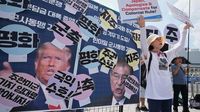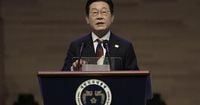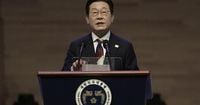South Korean President Lee Jae Myung, barely two months into his new administration, is stepping into the international spotlight with a pair of crucial summits in Tokyo and Washington this August—events that could reshape not only South Korea’s foreign policy posture, but also the delicate balance of power in Northeast Asia. As Lee prepares for back-to-back meetings with Japanese Prime Minister Shigeru Ishiba on August 23-24 and U.S. President Donald Trump on August 25, the stakes are high for all involved. These summits, as reported by both ABC and the Associated Press, encapsulate the mounting challenges U.S. allies face as they try to navigate Trump’s unpredictable and often unilateral approach to trade, security, and alliances.
At the heart of the matter is what some analysts have dubbed the “Trump risk”—the uncertainty and volatility introduced by Trump’s transactional style. For South Korea and Japan, this means grappling with demands for higher payments to support the U.S. troop presence, the threat of reduced American military commitments, and the constant specter of punitive tariffs. According to ABC, both Seoul and Tokyo have already managed to secure trade deals with Washington that spared them from the highest tariffs, but only after promising hundreds of billions of dollars in new U.S. investments. This reprieve, however, feels tenuous at best.
“There is now the Trump risk,” Choi Eunmi, an analyst at South Korea’s Asan Institute for Policy Studies, told the Associated Press. “There’s especially a lot of uncertainty in the business sector, so they might discuss ways to ease that uncertainty … not necessarily in joint efforts to confront Trump, but within the framework of trilateral cooperation.”
The timing of these summits is no accident. Lee’s office announced his Tokyo visit just a day after confirming his Washington summit, underscoring the urgency of aligning strategies with Japan before facing Trump’s demands. The meeting with Ishiba is about more than just optics; it’s a signal that the two countries, often at odds over historical grievances, are willing to set aside differences for greater regional stability. As Yukiko Fukagawa, a professor at Japan’s Waseda University, explained to AP, “Because they have to deal with increasingly challenging mutual counterparts, such as China and America, both Japan and South Korea are under pressure to set aside minor differences to cooperate on larger objectives.”
Among the agenda items for Lee and Ishiba: restarting long-stalled free trade talks and discussing South Korea’s potential entry into the Comprehensive and Progressive Agreement for Trans-Pacific Partnership (CPTPP), a major Asia-Pacific trade pact. Ishiba, who has met Trump twice this year, could also offer Lee some much-needed insights ahead of his White House visit.
But the shadow of North Korea and its burgeoning alliance with Russia looms large over these diplomatic efforts. Both South Korea and Japan are deeply alarmed by North Korea’s accelerating nuclear program and its growing cooperation with Moscow, especially in light of Russia’s ongoing war in Ukraine. This alignment not only complicates diplomatic efforts but also raises the stakes for regional security. The U.S. maintains about 30,000 troops in South Korea as a deterrent against North Korea—a presence now potentially in flux.
Trump’s approach, as both ABC and AP underline, is to demand more from allies. Seoul is bracing for the possibility that Trump will insist on higher payments to support the U.S. troop presence, or even look to scale back America’s military footprint in South Korea to refocus on China. This is a particularly thorny issue as South Korea balances its security needs with its economic reliance on China, its largest trading partner. The possibility that the Trump administration could reshape U.S. Forces Korea to focus more on China-Taiwan conflict readiness is very real, with potential impacts on troop size and roles.
Ban Kil-joo, a professor at South Korea’s National Diplomatic Academy, suggested to AP that it makes more sense for South Korea and Japan to work with the Trump administration under a trilateral framework, rather than negotiating separately. For example, the countries could propose a joint scheme to support Trump’s push to expand natural gas and other energy production in Alaska, which would also involve addressing security for maritime routes—a responsibility that could count toward defense cost-sharing or higher defense spending, as Trump demands.
Lee’s summit with Trump is also expected to include talks on fleshing out South Korea’s $350 million investment fund for U.S. industries, particularly shipbuilding—a sector Trump has spotlighted in relation to South Korea. Victor Cha, the Korea chair at the Center for Strategic and International Studies in Washington, told AP that Trump is eager to hear how South Korea intends to quickly bridge its trade surplus with the U.S., one of the largest among Washington’s NATO and Indo-Pacific allies.
But the thorniest question may be the future of the U.S.-South Korea military alliance, a legacy of the 1950-53 Korean War. The U.S. has long urged Seoul to accept greater flexibility in using American troops for missions beyond the Korean Peninsula—a demand that has only intensified under Trump. Senior U.S. officials have hinted that, in addition to pressing for more defense spending, the Trump administration could seek to reshape U.S. Forces Korea as part of a broader military focus on China and Taiwan. This would mean asking South Korea to take on a greater share of the burden against North Korea, while the U.S. pivots to counter China’s growing influence.
This shift could leave Seoul with fewer benefits but higher costs and risks, especially as the North Korean nuclear threat grows. South Korean lawmakers have even voiced concerns that Washington might seek Seoul’s commitment to intervene if conflict breaks out in the Taiwan Strait—a tricky proposition given South Korea’s economic ties with China and Beijing’s role in managing North Korea.
Ban Kil-joo advised that South Korea should enter the Trump summit with a clear stance on its role in regional security—possibly supporting U.S. efforts to maintain Indo-Pacific stability and opposing changes to the status quo, but without explicitly naming China as an adversary. According to Cha, Trump’s national security aides will want to hear more explicit South Korean commitments on its approach to China.
While South Korea may accept a more flexible role for U.S. Forces Korea, it will also seek U.S. assurances that deterrence and readiness against North Korea will not be compromised. As Ban noted, American troop deployments off the peninsula could be offset by increased airpower or the arrival of strategic assets like bombers—measures that would help prevent any miscalculation by the North.
As President Lee Jae Myung embarks on this high-stakes diplomatic journey, the outcomes of these summits could reverberate well beyond the region, shaping the future of U.S. alliances in Asia at a moment of profound uncertainty and change.



